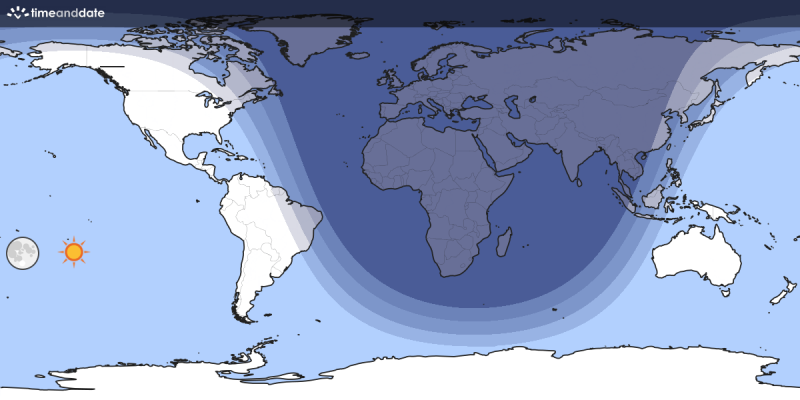A second of world darkness
For only a second on December 6, almost 9 in 10 folks worldwide will concurrently expertise nighttime.
A couple of months in the past, our quantity crunchers fact-checked (and partially confirmed) an web declare that 99% of the world’s population gets sunlight at 11:15 UTC on July 8. This left us questioning: What in regards to the reverse scenario? At what exact instantaneous do most individuals expertise nighttime?
Like final time, we fed our computer systems with timeanddate’s sun data for 2022 and inhabitants information from the Center for International Earth Science Information Network at Columbia College. We then calculated inhabitants information for the day, the evening, and the three twilight phases for each minute of each day of the 12 months.
Right here’s what we discovered.
December 6: Most individuals in nighttime
In keeping with our calculations, the second of most darkness occurs at 19:56 UTC on Tuesday, December 6, 2022. At that instantaneous, the sky might be fully darkish for about 85.92% of the world’s inhabitants. At that second, evening reigns throughout the three most populous continents: Asia, Africa, and Europe (with very minor exceptions).
How can or not it’s nighttime for nearly everybody?
Similar to at some other second, the sun will illuminate one half of the globe at 19:56 UTC on December 6. The opposite half might be darkish, and folks residing there’ll expertise nighttime.
The rationale why so many individuals might be in darkness is that the world’s most populated areas might be on the evening facet of Earth at that second. That features almost all of Asia, which is residence to about 60% of all people.
In the meantime, the Americas, New Zealand, and most of Australia might be bathed in daylight. Nevertheless, whereas being enormous landmasses, comparatively few folks reside there. North and South America mixed solely make up about 13% of our worldwide inhabitants.
Two twilit runners-up
Whereas it’s nighttime for most individuals on December 6, there’s additionally a case to be made for each December 21 and December 27 as various moments of most darkness.
You see, our computer systems spit out December 6 because the consequence solely once we ask them to stick to the strictest definition of nighttime. This definition says the sun have to be a minimum of 18 degrees under the horizon.
If the angle is lower than 18 levels, it’s twilight. That’s the time within the morning and within the night when oblique daylight brightens the sky to some extent.
December 27: Appears like evening for most individuals
The factor is, the darkest of the three twilight phases, astronomical twilight, is hardly discernible from the evening. The sun is between 12 and 18 levels under the horizon throughout that twilight phase. And the sky is so darkish that it looks like nighttime.
Once we allowed our algorithms to incorporate astronomical twilight, they calculated 19:39 UTC on Tuesday, December 27, 2022, because the second of peak darkness.
In keeping with our numbers, 86.11% of the world’s inhabitants experiences both nighttime (85.23%) or astronomical twilight (0.88%) at that instantaneous.
That’s roughly 15 million extra folks in comparison with the quantity we calculated for December 6. Nonetheless, it hardly strikes the needle on a world scale: The distinction accounts for a mere 0.19% of the world’s inhabitants.
December 21: Most individuals with out direct daylight
The second various instantaneous of peak darkness takes under consideration all twilight phases, together with nautical and civil twilight. Throughout these two phases, the sky is noticeably brighter. Nevertheless, there’s nonetheless no direct daylight.
Making use of this free definition of darkness, we arrived at 21:44 UTC on Wednesday, December 21, 2022, because the second when most of us are usually not within the daytime.
We calculated that this impacts 88.14% of the world’s inhabitants. Practically 9 out of 10 folks on Earth!

What’s so particular about these dates?
We weren’t significantly shocked that every one the dates fall within the northern winter. Most individuals reside north of the equator, and December is the month when the least amount of sunlight reaches the Northern Hemisphere.
However why does the variety of folks in darkness (or quasi-darkness) peak on these dates? Why does nighttime have an effect on extra folks on December 6 than on, say, December 5?
All of it depends upon how properly the form of the area affected by nighttime and twilight overlaps with the world’s most populated areas. That form adjustments very barely from one day to a different because the sun strikes southward earlier than the December solstice and northward once more after the solstice.
On the dates we discovered, it merely matches the contours of the world’s inhabitants facilities barely higher than on the day earlier than or after.
However once more, the distinction could be very, very small. Living proof: In keeping with our calculations, the variety of folks experiencing evening at 19:56 UTC on December 6 is 6,665,450,571; exactly 24 hours earlier, it’s 6,665,326,866. That’s a distinction of 123,705 folks, a tiny margin on a world scale.
Discovering the exact minute
As for the time of day when most individuals expertise darkness, it’s principally when Asia, Africa and Europe are on the evening facet of Earth.
Throughout that point of the 12 months, that occurs each day at 19-something UTC. That’s when evening has simply fallen in Europe. It’s additionally when the primary sun rays of the brand new day haven’t but reached the far east of Asia.
That stated, you in all probability observed that the time we calculated for December 21 (21:44 UTC) falls out of line. That’s as a result of the inclusion of nautical and civil twilight makes for a bigger geographical space. An space that now stretches all the best way from Japan within the east to a few of North America’s most populous metropolitan areas, reminiscent of New York and Montreal, within the west.
As you possibly can see within the screenshots of our Day and Night Map, it is just when together with the 2 brightest twilight phases that any good portion of North America’s inhabitants joins the “darkish facet.”
Wherever you’re, benefit from the darkish skies!
If this sounds too gloomy and might’t await days to get longer once more, allow us to sweeten the deal. Have a look at how a lot darkish skies have to supply throughout that point of the 12 months.
If the climate performs alongside, wrap up heat and go exterior to benefit from the spectacular Geminids meteor shower. At its peak on December 14-15, we anticipate about 150 capturing stars per hour.
A couple of days later, on December 22-23, the Ursids meteor shower peaks, bringing us about ten meteors per hour.
And whereas ready for the capturing stars to flit throughout the sky, you should use our Night Sky Map to identify planets and stars. Additionally, discover extra stargazing occasions in EarthSky’s Night Sky Guide.
Take it with a grain of salt
Whereas we’re assured in our calculations and information units, figuring out how many individuals expertise nighttime at anybody second is a somewhat messy enterprise.
For one, the world’s inhabitants isn’t static. It adjustments over time, and in some areas, it does so at a distinct tempo than in others. We based mostly our calculations on the most recent dependable inhabitants information we might discover, however they’re from 2020.
What’s extra, the margins are minuscule. Whereas our algorithms recognized a particular instantaneous when most individuals expertise evening, in addition they gave us loads of different dates and occasions in the course of the Northern Hemisphere winter with a nighttime inhabitants that’s only a tiny fraction smaller. We’re speaking a couple of tens of 1000’s of individuals. Peanuts in comparison with the world’s inhabitants.
Backside line: On December 6, the most important proportion of the human inhabitants sees a second of world darkness.





